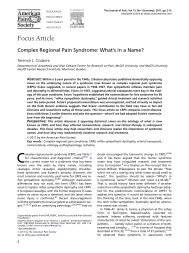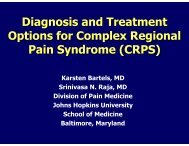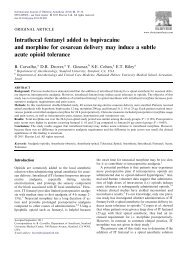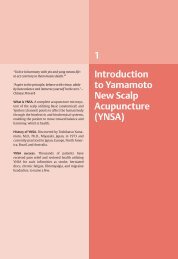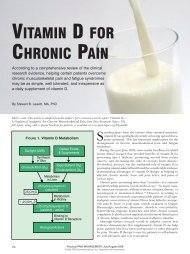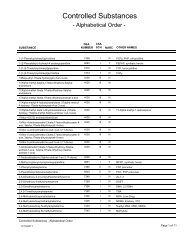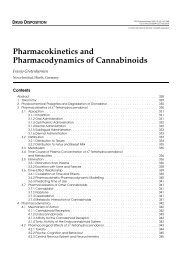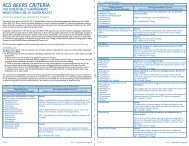GLIA: A NOVEL DRUG DISCOVERY TARGET FOR CLINICAL PAIN
GLIA: A NOVEL DRUG DISCOVERY TARGET FOR CLINICAL PAIN
GLIA: A NOVEL DRUG DISCOVERY TARGET FOR CLINICAL PAIN
You also want an ePaper? Increase the reach of your titles
YUMPU automatically turns print PDFs into web optimized ePapers that Google loves.
REVIEWSaFigure 3 | Microglia, as well as astrocytes, are activated by manipulations that createenhanced nociception in animal models. Although the earliest studies focused on theactivation of astroctyes, microglia are also activated. These photomicrographs provide oneexample of microglial activation in response to a manipulation (intrathecal HIV-1 glycoprotein120) that produces robust mechanical allodynia and thermal hyperalgesia. Microglia are stainedfor expression of complement-3 receptor, which is upregulated when microglia are activated.a | Normal microglia in the dorsal horn of the spinal cord after peri-spinal injection of vehicle(control). b | Same magnification view of dorsal horn microglia after peri-spinal injection of a viralprotein (HIV-1 glycoprotein 120), which induces exaggerated pain responses. Modified, withpermission, from REF. 12 © Elsevier Science Ltd (2001).IMMUNOCOMPETENTFunctioning similar to immunecells; that is, expressingreceptors for bacteria/virusesand releasing pro-inflammatorycytokines and other immunecell products on activation.NEUROPATHIC <strong>PAIN</strong>Allodynia/hyperalgesia causedby inflammation of and/ortrauma to peripheral nerves.IL-6-NEUTRALIZINGANTIBODIESAntibodies that bind to IL-6and so prevent IL-6 frombinding to its receptor.bHowever, studying the effects of such neurotransmitterson glia in vivo is confounded by the fact that thesesubstances would also activate spinal neurons.The first approach that has been used to examinewhether glial activation is sufficient to create enhancednociception rests on the fact that both astrocytes andmicroglia are IMMUNOCOMPETENT cell types. That is,whereas microglia are of haematopoietic (immune) celllineage 29,30 (although this is not without controversy 31 ),astrocytes can also behave, in many regards, likeimmune cells, despite their neural-tube origins 32 .Ofdirect relevance here is that they express receptors for,and are activated by, viruses and bacteria 33 .So studieshave examined the effect of injecting the immunogenicportions of bacteria and viruses over spinal cord. Glialactivation and exaggerated pain responses occur as aresult 16,18,34 .Glial activation is causal to the allodynia andhyperalgesia observed in these studies, as the painchanges are blocked by disruption of glial function 16,18,34 .A second and very recent approach for examiningthis issue has tested the role of fractalkine (also knownas chemokine (C-X3-C motif) ligand-1) in pain facilitation.Fractalkine is a protein that is tethered to the extracellularsurface of neurons 35 .In spinal cord, no cell typesother than neurons express fractalkine 36,37 .In responseto strong neuronal activation, fractalkine can be releasedand diffuse away 38 .In spinal cord, only microglia expressreceptors for fractalkine (FIG. 4).So, fractalkine is aputative neuron-to-glia signal. The administration ofexogenous fractalkine produces allodynia and hyperalgesiathrough binding to CX3CR1, the only knownreceptor for fractalkine 36,37 .Furthermore, the blockadeof endogenous fractalkine attenuates allodynia andhyperalgesia induced in animal models of NEUROPATHIC<strong>PAIN</strong>, indicating that peripheral-nerve inflammation andinjury lead to the release of fractalkine from neurons indorsal spinal cord 36,37 .So neuron-to-glia signalling, hereevoked by fractalkine activation of microglia, againseems to be sufficient to create pain facilitation.Mechanisms of glial pain enhancementThe mechanisms by which glial activation enhancesneuronal transmission of nociceptive information areonly partially understood. Ultimately, activated spinalcord glia must lead to hyperalgesia and allodynia byreleasing substances that act on neurons in the painpathway(s). These substances could have a variety ofactions: they could direct excitation, sensitization, orpotentiation of action potentials; direct the upregulationof neuronal receptors; and promote the inductionof the release of other transmitters/modulators that canact on nocisponsive neurons.To date, most evidence has supported a putative rolefor the glial pro-inflammatory cytokines tumournecrosisfactor (TNF), interleukin-1 (IL-1) and IL-6.Pro-inflammatory cytokines are classically known as afamily of proteins released by activated immune cells.There is no amino-acid sequence motif or three-dimensionalstructure that links them; rather, they aregrouped on the basis of their biological activities 39 . TNF,IL-1 and IL-6 came to be classified as pro-inflammatorybecause they orchestrate the early immune responseto infection and injury by communicating with whiteblood cells, thereby attracting them to the site ofinfection/injury, and causing them to become activatedand respond 39 .Peripherally, and in the CNS, these proinflammatorycytokines are often sequentially formedin a cascade in which TNF is typically made first, causingthe induction of IL-1, which in turn causes the inductionof IL-6. It is an important feature that the effects of proinflammatorycytokines synergize (especially TNFand IL-1), such that far more powerful effects areobserved when more than one cytokine is present 39 .TNF and IL-1, in particular, are very potent biologicalmolecules, producing large effects when administeredin the CNS in the femptogram to picogram range 33 .Indeed it has been estimated that as few as four moleculesof IL-1 need bind to a cell to induce a physiologicalresponse 39 .Appropriately, given this potency, the productionand release of pro-inflammatory cytokines istightly regulated, and numerous negative-feedbackcontrol systems exist (such as the production of antiinflammatorycytokines, ‘decoy’ receptors and antagonistsof receptors for pro-inflammatory cytokines)which can help suppress the production and functionof pro-inflammatory cytokines 33 .Both astrocytes and microglia can release proinflammatorycytokines on activation 33 (FIG. 5), and gliaand neurons express receptors for them. In the brain,pro-inflammatory cytokines have a wide array ofeffects on the regulation of core body temperature, sleep,learning and memory, and hypothalamo–pituitary hormones40 .The injection of exogenous pro-inflammatorycytokines over the spinal cord enhances nociception 41–44 ,and electrophysiological studies document rapidenhancement of neuronal excitability in response tonoxious stimuli following the injection of proinflammatorycytokines to the region 43,45 .Conversely,the blockade of pro-inflammatory cytokine function,using either an IL-1-receptor antagonist, soluble TNFreceptors or anti-IL-6-NEUTRALIZING ANTIBODIES,preventsNATURE REVIEWS | <strong>DRUG</strong> <strong>DISCOVERY</strong> VOLUME 2 | DECEMBER 2003 | 977



